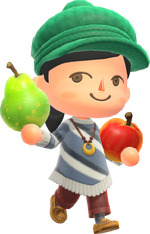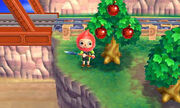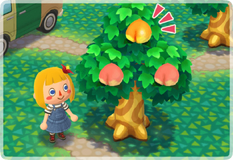Фрукт
Фрукты — это обычные продукты, которые растут Из фруктовых деревьев и пальм во всех играх Animal Crossing: New Leaf, новые фрукты были добавлены в серию впервые с Animal Forest+. Личи, дурианы, лимоны, бананы, манго и хурма* являются новыми дополнениями. Каждый фрукт можно купить на острове Тортимера или в T&T Emporium, и каждый Из них продается за 250 диней. Кроме того, цены на кокосы были зафиксированы на уровне 250 диней, поскольку теперь они являются фруктами острова. Еще одно дополнение — возможность складывать девять предметов одного и того же фрукта, экономя место в инвентаре. Тем не менее, фрукты не складываются автоматически, и игрок должен сложить их вручную.
- Хурму можно приобрести только в T&T Emporium или у жителей. В T&T Emporium они стоят 1000 диней, и их нельзя найти на острове Тортимера. Однако их можно найти в Турах.
Получение фрукта [ ]
Различные фрукты можно получить в качестве награды или подарка От жителей, или От мамы игрока в Animal Crossing: Wild World и Animal Crossing: New Leaf. В большинстве игр отправка жителю однострочного письма с кусочком фрукта может привести к случайной отправке плодов в ответ. В Animal Crossing: New Leaf Изабель в конце концов даст игроку три куска второго, не родного фрукта, когда её урок будет завершен. ЭтОт фрукт всегда один Из стартовых. Кокосы можно найти по-разному. В играх GCN они получены с острова. В Animal Crossing: Wild World и Animal Crossing: City Folk они случайно появляются на пляже. В Animal Crossing: New Leaf они получаются с острова Тортимера.
В Animal Crossing: New Leaf игрок может получить не родные фрукты во время Праздника урожая, когда ловит рыбу, которую просил житель. Также можно получить любой вид фруктов, оказывая услуги жителям.
Фруктовые деревья [ ]
Фруктовые деревья — это особые деревья, которые выращивают три куска фруктов каждые три дня. Существует баг в Animal Crossing: New Leaf, где фруктовое дерево содержит менее трёх кусочков фруктов. Кокосовые пальмы должны быть посажены в пределах одного акра моря, и все деревья должны расти как минимум в одном месте От других объектов. Банановые деревья должны быть посажены на пляже. Фрукты можно стряхивать с деревьев, которые их несут.
Идеальный фрукт [ ]
Идеальные фрукты впервые появились в Animal Crossing: New Leaf. Любые Из первых пяти фруктов (яблоки, апельсины, персики, груши и/или вишня) могут быть идеальными и немного отличаться От своих обычных аналогов. Обычно, по крайней мере, один идеальный фрукт родного типа появляется в начале игры. Деревья могут очень редко давать идеальные плоды, хотя захоронение удобрений рядом с деревом увеличивает шансы на это. Идеальный фрукт продается за 600 диней, если он родной, или 3000 диней, если не родной. Они могут быть выращены только в городе, где это родной плод, и у деревьев не будет шансов принести идеальный плод, если это не родной плод города. Если игрок попытается посадить идеальное фруктовое дерево там, где это не родной фрукт, он просто создаст обычное фруктовое дерево. Однако, когда родной идеальный фрукт высажен, он вырастит идеальное фруктовое дерево.
Идеальные деревья дают до трёх идеальных плодов до семи раз. При последнем встряхивании они потеряют свои листья и не вырастут или не принесут дальнейших плодов, если не будут пересажены. Кроме того, в последней партии одним Из идеальных фруктов будут гнилые фрукты. «Мёртвое» дерево можно срубить, чтобы заменить. Кроме того, захоронение удобрений рядом с мёртвым идеальным деревом приведёт к тому, что оно вырастет на следующий день. У гнилых фруктов плата за утилизацию составляет 500 диней, если они родные, или 3000 диней, если они не родные, и если их посадить, это создаст мёртвый саженец. Однако их можно накормить жителю, который хочет фрукты любого рода, хотя они будут противны им (они забудут об этом позже). Если игрок оставляет на земле гнилые плоды, на него регулярно будут попадаться муравьи, и их легко будет поймать. Гнилые плоды выглядят точно так же, как и их здоровые аналоги.
В New Horizons [ ]
В New Horizons всего 5 видов фруктов, которые могут быть родными на острове игрока (апельсин, вишня, груша, персик, яблоко) и кокос. Родные фрукты острова растут на деревьях сразу после начала игры и продаются в лавке Нука. Не родные фрукты с островов других игроков или путешествуя по необитаемым островам (через аэропорт за Билет а мили Нука). В инвентаре и хранилище фрукты автоматически собираются в стак до 10 штук.
Список фруктов в New Horizons [ ]
| Название | Иконка | Кол-во на дереве | Цена продажи |
|---|---|---|---|
| Яблоко | 3 | 100 ( 500 ) | |
| Вишня | 3 | 100 ( 500 ) | |
| Апельсин | 3 | 100 ( 500 ) | |
| Персик | 3 | 100 ( 500 ) | |
| Груша | 3 | 100 ( 500 ) | |
| Кокос | 2 | 250 |
Источник
Fruit
Fruit are common items that grow from fruit trees and palm trees in all Animal Crossing series titles. They can be eaten and are sometimes requested by villagers.
Each town starts with one of five types of fruit as its native fruit: Apples, Oranges, Cherries, Pears, or Peaches. There is a 20% chance for the town to have any given native fruit. Native fruits sell for 100 Bells, but non-native fruits sell for 500. Up until New Leaf, coconuts also sold for 500 bells, as they weren’t native to any town, but sell for 250 bells in New Leaf and New Horizons.
In New Leaf, new fruits have been added to the series for the first time since Animal Forest+: Lychees, Durians, Lemons, Bananas, Mangoes, and Persimmons. Some of these types of fruit are considered tropical fruit, each of which are available from Tortimer Island or from T&T Emporium, selling for 250 Bells each. In addition, coconuts have had their price fixed at 250 bells since they are now an Island fruit. Another addition is the ability to have ten items of the same fruit to be stacked, saving space in the inventory.
Pocket Camp introduced Grapes to the series.
Contents
List of Fruit [ ]
Obtaining Fruit [ ]
Throughout the games, there are many ways the player can obtain different fruit. One consistent method throughout the Animal Crossing series is that fruit can be obtained as a gift from Mom or from villagers. Sending a villager a one-line letter with a piece of fruit can initiate a random fruit being sent in return.
Fruit can be shaken out of their own trees that bear three pieces of fruit every three days. Coconut and banana trees must be planted on the beach and all trees must grow with one tree’s span between them.
Animal Crossing, Wild World, and City Folk [ ]
Coconuts are found in various ways. In GCN games, they are obtained from the Island. In Wild World and City Folk, they randomly wash up on the beach.
New Leaf [ ]
All fruits can be obtained from Tortimer Island either through the island itself or on an Island Tour. (Except for the Labyrinth Tour, where you can only collect one specified fruit that you can’t keep.)
In New Leaf, Isabelle will eventually give the player three pieces of a second, non-native fruit when her tutorial has been completed. This fruit is always one of the five starting fruits. The non-native fruit given by her depends on the native fruit of the town. For instance, a town whose native fruit is cherries will receive apples as Isabelle’s gift.
In New Leaf, the player may get non-native fruits during the Harvest Festival when catching a fish that a villager requested. It is also possible to get any kind of fruit by doing favors for villagers.
Any of the five starting fruit types can be requested by villagers, provided that fruit type is available in town.
Persimmons can be purchased from T&T Emporium for 1,000 Bells.
Pocket Camp [ ]
In Pocket Camp, all five possible native fruits grow on trees in Breezy Hollow and two of them grow in Lost Lure Creek, with coconuts growing in Saltwater Shores and Sunburst Island. Additionally, either lemons, lychee, or grapes grow on trees in both Breezy Hollow and Lost Lure Creek, but only one of the three is native. In order to get the other two, you have to buy them from other players at their Market Box. Fruit takes three hours to grow back when shaken down and can grow back instantly if the player uses fertilizer.
New Horizons [ ]
In New Horizons, fruit can be obtained by using a Nook Miles Ticket and going on a Mystery tour. This is a guaranteed method of finding coconuts.
Perfect Fruit [ ]
Perfect fruits appear in New Leaf and Pocket Camp. Any of the native fruits (apples, oranges, peaches, pears, and cherries) can be perfect, which gives them a slightly different look from their regular counterparts. In Pocket Camp, grapes, lemons and lychees can also be perfect. Pocket Camp also introduced a small chance that two perfect fruits appear on a tree.
Usually, at least one perfect native fruit appears at the start of the game. Trees can very rarely yield perfect fruit, though burying fertilizer next to the tree increases the chances of this happening. Perfect fruit sells for 600 bells if native or 3,000 bells if not native.
Perfect fruit trees [ ]
Perfect trees yield three perfect fruits up to seven times. It can only be grown in a town where it is the native fruit by burying a perfect fruit. If the player tries to plant a perfect non-native fruit tree, it produces only regular fruit.
On the last shake, perfect fruit trees lose their leaves and do not regrow or bear any further fruit unless replanted. Additionally, on the final batch, one of the perfect fruits will be rotten. The dead tree can be cut down to be replaced. Burying fertilizer next to a dead perfect tree causes it to regrow the next day. Rotten fruits have a disposal fee of 500 bells if they are native or 3,000 Bells if not native, and if one is planted, it creates a dead sapling. However, they can be fed to a villager wanting fruit of any kind, though it shall disgust one. If a player leaves a rotten fruit on the ground, ants will regularly come onto it and can be caught. Rotten fruit looks the same as its healthy counterpart.
Источник



